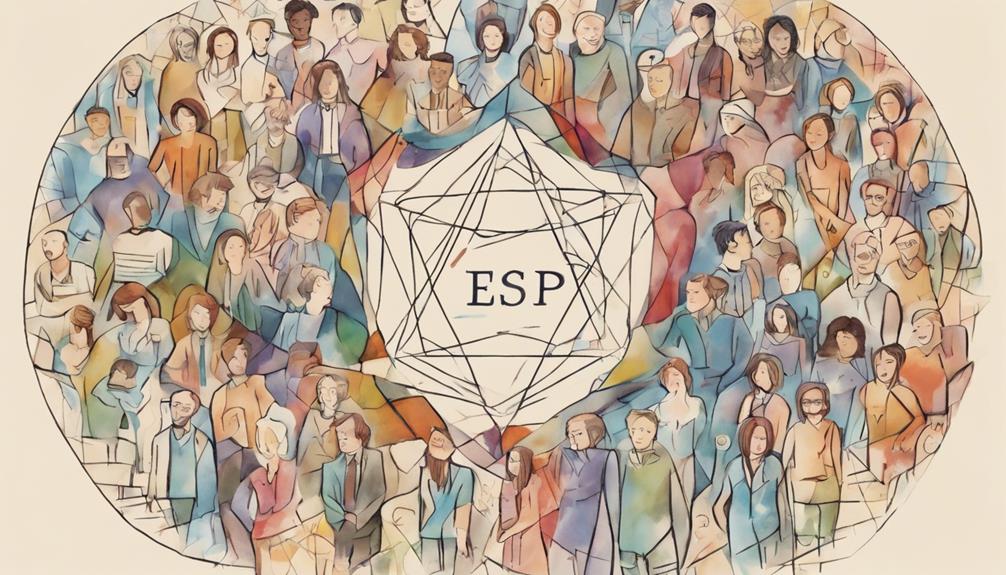Let’s pause to appreciate the forever mysterious Enneagram Type 4 – a domain where feelings dominate and profundity is limitless.
As we venture into the world of subtypes within Type 4, we'll uncover a tapestry of intricacies that shape individuals in ways beyond the surface.
From the self-preservationist's guarded authenticity to the social butterfly's intricate dance of belonging, and the magnetic allure of the sexual subtype, each holds a key to unlocking a deeper understanding of ourselves and others.
The journey through these subtypes promises a revelation that might just reshape how we view the complexities of human nature.
Key Takeaways
- Self-Preservation 4s focus on personal security and practicality for inner stability.
- Social 4s seek uniqueness and deeper emotional connections in social interactions.
- Sexual 4s navigate intense emotions and competitive yearnings with authenticity.
- Understanding Enneagram 4 subtypes aids in navigating inner worlds and relationships effectively.
Overview of Enneagram Type 4 Subtypes
In exploring the diverse landscape of Enneagram Type 4 subtypes, we delve into the nuanced manifestations of individuality and emotional depth within this personality type. The Enneagram Fours are known for their deep connection to their emotions and a profound sense of uniqueness. The subtypes – Self-Preservation, Sexual, and Social – each bring forth distinct characteristics that shape how Fours express their emotional authenticity and quest for individuality.
The Self-Preservation Type 4s focus on ensuring their security, comfort, and practical needs while still striving to maintain their unique identity. They navigate the world by balancing their desire for distinctiveness with the necessities of daily life.
The Sexual Type 4s, on the other hand, channel their intense emotions and inner sense of lack into creating depth in their relationships and pursuits, often engaging in a subtle form of competition to overcome their internal deficiencies.
Lastly, the Social Type 4s seek validation and support from their community, using their expressions of suffering to highlight their uniqueness and connect with others who share their emotional depth. Understanding these subtypes provides valuable insights into how Enneagram Fours navigate their inner worlds and external relationships with a focus on emotional authenticity and individuality.
Self-Preservation Type 4 Characteristics

Embodying a focus on personal security, physical well-being, and material comforts, Self-Preservation Type 4 individuals navigate their lives with a practical and frugal approach, prioritizing stability and safety. These individuals are cautious in their interactions, taking time to establish relationships that bring a sense of security and comfort. However, they may struggle with practicing self-care, often prioritizing the needs of others over their own well-being.
Self-Preservation Type 4s seek to create inner security through self-sufficiency and by curating a comfortable environment. They appreciate tangible expressions of their emotional depth, often channeling their feelings into art, music, or personal possessions. These individuals value stability and safety, making them adept at planning for contingencies and ensuring they've the resources needed to feel secure.
In essence, Self-Preservation Type 4s approach life with a blend of practicality and emotional depth, balancing the desire for material comforts with a need for inner security and stability.
Social Type 4 Traits
Navigating their social sphere with a yearning for uniqueness and significance, Social Type 4 individuals seek deeper emotional connections and a sense of honor within their relationships. These individuals are characterized by their emotional sensitivity and a deep desire for validation and recognition from others. Social Type 4s often feel misunderstood, grappling with feelings of shame while striving to stand out and be appreciated for their distinct qualities.
They express their inner suffering openly, using their emotions as a way to attract support and empathy from those around them. Building meaningful social connections is crucial for Social Fours, as they aim to create a sense of honor and uniqueness within their social circles. Despite their intense emotions and struggles, these individuals continue to seek deeper emotional bonds that provide them with the validation and understanding they crave in their quest for significance and connection.
Sexual Type 4 Attributes
Driven by intense emotions and a relentless pursuit of deep connections, Sexual Type 4 individuals exhibit a compelling mix of competitiveness and a yearning to transcend internal deficiencies through passionate endeavors. This subtype of Type 4 thrives on the intensity in relationships, seeking profound emotional experiences that set them apart from others.
Here are some key attributes of Sexual Type 4s:
- Envy and Uniqueness: They may grapple with feelings of envy towards others while simultaneously cherishing their sense of individuality and uniqueness in emotional encounters.
- Intensity in Relationships: Seeking depth and intimacy, they navigate the highs and lows of emotional connections with fervor and dedication.
- Competitiveness and Passion: Driven by a competitive edge, they channel their emotions into passionate pursuits, striving to excel and stand out in their endeavors.
- Emotional Sensitivity and Internal Struggles: Despite their emotional sensitivity, they confront internal deficiencies with a determination to overcome them through their deep, authentic expressions of self.
Frequently Asked Questions
What Is the Rarest Enneagram Type 4?
The rarest Enneagram Type 4 is often considered to be the Self-Preservation Four. This subtype focuses on survival needs and security, leading to a unique approach within the Type 4 framework.
Traits like thriftiness, self-reliance, and a desire for stability and comfort characterize Self-Preservation Fours. Understanding this rare subtype can offer valuable insights into the diverse expressions of Type 4 personalities, enriching our mastery of the Enneagram system.
What Are the Subtypes of Enneagram 4?
Enneagram 4 has three subtypes: Self-Preservation (SP), Sexual (SX), and Social (SO). Each subtype brings nuanced characteristics to the core type, influencing behaviors and motivations.
SP 4 focuses on enduring pain and pursuing passions with stoicism.
SX 4 competes to overcome internal deficiencies, intensifying emotions.
SO 4 seeks support by expressing suffering and striving for honor.
Understanding these subtypes enhances our mastery of Enneagram 4's complexities.
What Is the Rarest Enneagram Subtype?
The rarest Enneagram subtype is the Self-Preservation subtype for Type 4. This subtype focuses on survival needs and practical concerns, making it less common than the Social and Sexual subtypes of Type 4.
Self-Preservation Fours display traits like frugality, security concerns, and a strong sense of self-preservation. Understanding this unique subtype offers valuable insights into the complexity of Enneagram Type 4 personalities.
What Are Enneagram 4 at Their Worst?
At their worst, Enneagram 4s can spiral into self-absorption and intense moodiness. They may wrestle with envy, longing, and a persistent feeling of being misunderstood. Seeking attention and validation, they can become overly sensitive.
In the depths of unhealthiness, they isolate themselves, withdrawing from relationships. Dwelling on perceived deficiencies, they often experience profound abandonment and unfulfillment. It's a complex dance of emotions that can consume us if left unchecked.
Conclusion
As we journey through the intricate tapestry of Enneagram Type 4 subtypes, we uncover a rich array of colors and textures that make up the essence of our authentic selves.
Just as each stroke of a painter's brush contributes to the masterpiece, each subtype of Type 4 adds depth and complexity to our inner landscape.
Embracing our unique blend of self-preservation, social, and sexual instincts allows us to paint our own canvas of personal growth and self-awareness.
Felicity, our Author, pens in-depth articles and guides that delve into the heart of personal discovery. Her narrative-driven approach weaves together theory, practice, and personal anecdotes, making the journey of self-exploration both relatable and inspiring. Felicity’s contributions help illuminate the path for those seeking a deeper understanding of themselves and their relationships.










